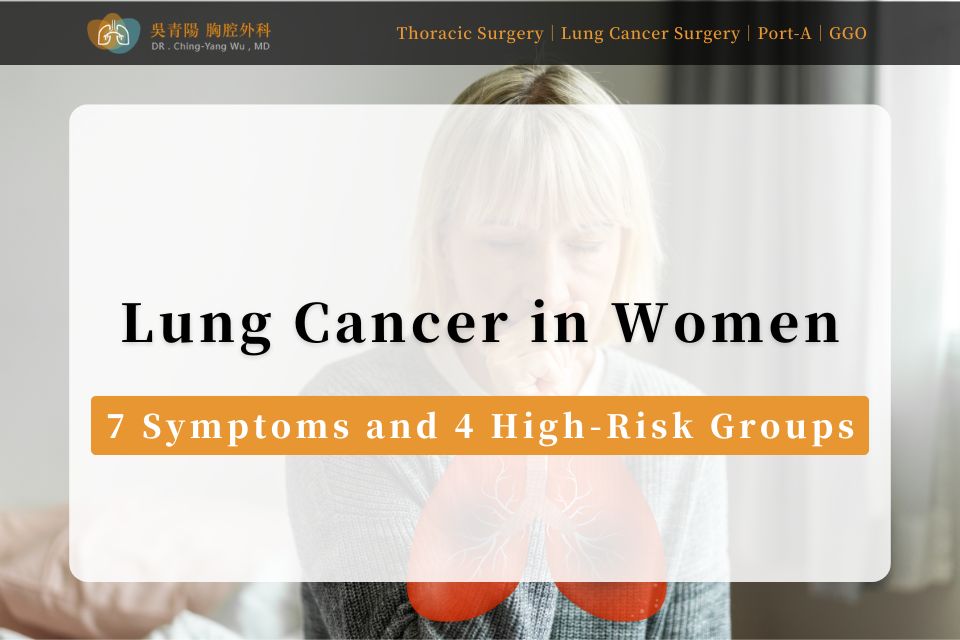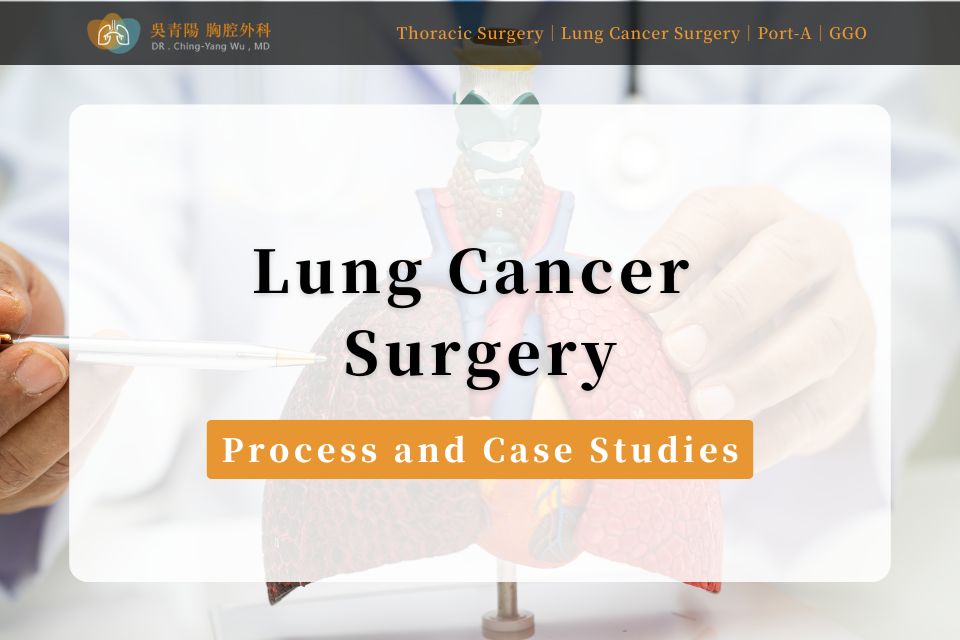
Lung Cancer in Women: 7 Symptoms and 4 High-Risk Groups
Lung Cancer in Women: 7 Symptoms and 4 High-Risk Groups
The symptoms and signs of lung cancer in women are often overlooked, as the clinical presentation of lung cancer tends to be diverse and non-specific.
Because these symptoms are subtle, they rarely lead to an immediate suspicion of a malignant lung tumor.
In general, patients with early-stage lung cancer often do not exhibit obvious signs or symptoms of lung cancer in women.
This is because early-stage tumors are typically confined to a single lung lobe or segment and have not yet invaded surrounding structures.
The tumor is relatively small compared to the overall lung volume and does not significantly affect pulmonary ventilation function.
However, as the disease progresses to a more advanced stage, clinical symptoms become closely related to local tumor invasion and distant metastasis.
If signs and symptoms of lung cancer in women are ignored over time, it may lead to missed opportunities for early treatment.
That’s why recognizing the potential signs of lung cancer in women and seeking timely medical evaluation is especially important for women.
Lung Cancer in Women
Are Lung Cancer Symptoms More Common in Women Than in Men?
While the incidence rate of lung cancer doesn't show a significant difference between men and women overall, certain specific factors make women more susceptible to developing lung cancer in some situations.
In particular, women have a higher risk of developing lung adenocarcinoma.
7 Common Symptoms of Lung Cancer in Women
- Fever (obstructive pneumonia)
- Facial swelling (superior vena cava syndrome)
- Back pain or bone pain (bone metastasis)
- Hemoptysis (tumor bleeding into the airway or necrotic tissue expelled via the airway)
- Headache, seizures, and other neurological symptoms (central nervous system metastasis)
- Shortness of breath (lung collapse due to malignant pleural effusion or obstructed blood flow from pericardial effusion)
- Wheezing (tracheal narrowing caused by tumor or metastatic mediastinal lymph node compression/invasion)
4 High-Risk Groups for Lung Adenocarcinoma in Women
When screening for lung cancer, women should pay special attention to their smoking history and individual risk factors to allow for early detection and timely treatment.
Among high-risk groups, women with the following characteristics should be especially vigilant about undergoing lung cancer screening.
- Long-term smokers, especially those smoking over a pack a day.
- Women exposed to secondhand smoke over extended periods.
- Those with a family history of lung cancer, especially in first-degree relatives.
- Women with a history of breast cancer, lymphoma, or head and neck cancer who had chest radiation.
For high-risk groups of female lung adenocarcinoma patients, screening is primarily conducted using low-dose computed tomography (LDCT).
LDCT is highly effective in detecting early-stage lung cancer and has been shown to help reduce mortality in high-risk individuals.
Currently, gender-specific screening considerations focus primarily on women with a smoking history or other established risk factors.
Routine lung cancer screening is not recommended for women without these high-risk features.
For more information, individuals can refer to the “Health Promotion Administration – Lung Cancer Screening Hospitals” website.
Lung Cancer Screening Items
- Low-Dose Computed Tomography (LDCT):Effectively detects abnormal lung nodules or tumors.
- Ultrasound of the Thyroid, Breasts, and Liver:Helps identify tumors or cysts in related organs.
- Coronary Artery Calcium Scoring:Used for further assessment in patients with a history of chronic diseases.
- Contrast-Enhanced CT Scan:Performed for positive findings to provide a more precise evaluation of the tumor and determine whether surgery or other treatments are necessary.
Lung Cancer Screening: Results & Follow-Up
Among high-risk female patients undergoing lung cancer screening, the results can generally be categorized into several types.
These classifications are particularly relevant when analyzing cases of female lung cancer and female lung adenocarcinoma, taking into account their unique clinical features.
Normal:
Defined as the absence of female lung cancer or any suspicious abnormalities.
Regular follow-up imaging is generally recommended according to clinical guidelines.
For high-risk individuals, annual lung cancer screening is advised to enable early detection of female lung adenocarcinoma or other lung cancer symptoms in women.
Positive Findings:
A space-occupying lesion is identified in the LDCT scan area (from the lower neck to the upper abdomen).
Since low-dose computed tomography (LDCT) does not use contrast agents, it is difficult to distinguish high-perfusion organs from surrounding soft tissue.
The clarity of the image depends on the density difference between the lesion and adjacent structures.
Clinical scenarios and management are as follows:
Thyroid cysts or tumors:
A thyroid ultrasound is recommended.
If necessary, fine-needle aspiration (FNA) should be performed to confirm the diagnosis and avoid overlooking potential risks related to female lung cancer.
Breast tumors or calcifications:
A breast ultrasound is advised.
If needed, a tissue biopsy can help confirm the diagnosis and assess the possibility of metastasis from female lung adenocarcinoma.
Mediastinal tumor:
A contrast-enhanced CT scan is recommended for further evaluation of tumor invasion.
If the tumor is potentially resectable, surgical removal is advised.
Further treatment and follow-up planning should be based on the final pathology report, with special adjustments for female lung cancer cases.
Coronary artery calcification:
For patients with chronic conditions such as hypertension, hyperlipidemia, or diabetes, referral to a cardiologist is recommended to assess possible coronary artery obstruction.
Managing cardiovascular risk is important to avoid compromising the effectiveness of female lung cancer treatment.
Pulmonary nodule:
Follow-up or treatment depends on the size and density of the lesion (refer to lung cancer screening guidelines).
Women should pay particular attention to the possibility that the nodule may represent early female lung adenocarcinoma.
Adrenal tumor:
A contrast-enhanced CT scan is recommended for further evaluation.
In patients with female lung cancer, special attention should be given to the possibility of metastatic disease.
Liver cyst:
A liver ultrasound is recommended to rule out the possibility of female lung adenocarcinoma metastasis to the liver.
In addition, for women with a history of breast cancer, non-Hodgkin lymphoma, or head and neck cancer who have received chest radiation therapy, lung cancer screening should take into account the patient’s overall risk.
This includes factors such as smoking history, prior radiation exposure, family history, age, and time since smoking cessation, as well as the potential for metastasis related to female lung cancer and female lung adenocarcinoma.
The timing of screening may depend on when the patient completed cancer treatment and their current health condition.
Screening typically begins a few years after treatment, especially during the remission phase, if the individual meets the criteria for being high-risk for female lung cancer.
How Is Female Lung Cancer Treated?
The treatment principles for female lung cancer are generally the same as those for male patients.
The treatment plan is primarily determined by the stage of the tumor (extent of invasion), and is outlined as follows:
★ Treatment Plan (Based on Clinical Tumor Staging)
The treatment plan for female lung cancer, particularly female lung adenocarcinoma, is primarily based on clinical tumor staging.
For patients with adequate cardiopulmonary function, those with clinical staging earlier than stage IIIA may be eligible for complete surgical resection of the tumor.
For patients with clinical stage IIIB or IV lung cancer, genetic testing is recommended to identify targeted therapies, or chemotherapy may be considered as part of the treatment plan.
★ Treatment Options and Prognosis
Surgical Treatment:
Recommended for early-stage female lung cancer (Stage I to IIIA), with the potential for curative outcomes and a high five-year survival rate.
Chemotherapy:
Suitable for Stage II or higher, or for patients who are not surgical candidates.
Often combined with other treatments to improve survival.
Targeted Therapy:
For female lung adenocarcinoma patients with EGFR mutations identified through genetic testing.
Treatment with Osimertinib may extend progression-free survival.
Radiation Therapy:
Used for patients who are inoperable or have metastatic disease.
Mainly aims to relieve symptoms.
Immunotherapy:
Commonly used in advanced-stage female lung cancer to help improve overall survival rates.
★ Postoperative Treatment and Follow-Up Plan
For female lung cancer patients who are eligible for tumor resection, the postoperative treatment plan should be adjusted based on the pathological staging determined by the pathologist’s examination of the surgical specimen.
Special attention should be given to monitoring the risk of recurrence, particularly in cases presenting with lung cancer symptoms in women.
Dr. Ching-Yang Wu: Hope for Female Lung Adenocarcinoma
Lung cancer symptoms in women, especially in cases of female lung adenocarcinoma, are often subtle and variable.
Because of this, they are frequently overlooked, leading to missed opportunities for early treatment.
Dr. Ching-Yang Wu, a thoracic surgeon with extensive clinical experience, specializes in the diagnosis and treatment of female lung cancer.
His expertise has brought new hope to many patients.
If you or your loved one is facing concerns related to female lung cancer or female lung adenocarcinoma, we encourage you to schedule a professional consultation via LINE.
Take the first step in safeguarding your health.
Dr. Ching-Yang Wu’s Four Key Strengths in Thoracic Surgery
Extensive Thoracic Surgery Experience
Former attending surgeon at Linkou Chang Gung, skilled in lung and mediastinal tumor surgeries with expertise in minimally invasive techniques.
Personalized Treatment Planning
Offers tailored therapies for female lung cancer based on TNM staging, including surgery, chemo, targeted, or immunotherapy.
Advanced Therapy Expertise
Keeps up with the latest in female lung adenocarcinoma care, especially EGFR mutation-targeted treatment like Osimertinib.
Comprehensive Aftercare
Emphasizes regular imaging follow-up and full support for recurrence prevention in female lung cancer patients.



